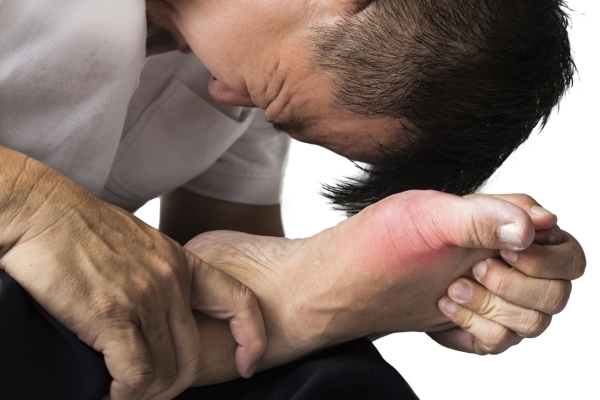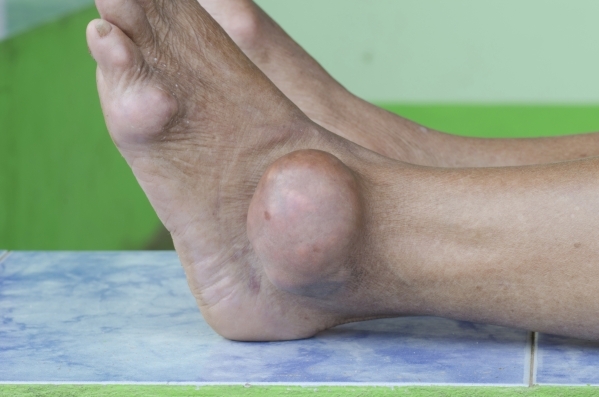Changing diet, medications fight painful gout
Nothing like kicking back and eating a nice juicy steak, maybe some shellfish on the side and washing it all down with a couple of beers. Unfortunately, this feel-good diet, if followed too often, is rich in purines, which in turn may raise uric acid levels in your body and lead to a condition commonly referred to as the dreaded "disease of kings" — gout.
People who experience sudden attacks of gout, which is a complex form of arthritis, also experience severe pain and warmth in their joints, which become swollen, inflamed and tender. This is brought on by the formation of sharp, needlelike urate crystals accumulating in the joints. Normally, uric acid dissolves in the blood and passes through the kidneys during urination. But if the body produces too much uric acid, or the kidneys excrete too little, then conditions are primed for a bout of gout.
The most common area for a gout attack is the big toe, and it usually happens at night. However, attacks can also affect the ankles, knees, hands and wrists. Gout can last anywhere from a few days to a few weeks.
A diet rich in purines is not the only contributing factor for gout (though it is the reason for the royal connection to kings, since they had greater access to those types of food). Being overweight causes your body to produce more uric acid, and your kidneys have a difficult time passing the uric acid. Certain medical conditions such as having high blood pressure, diabetes, metabolic syndrome and heart and kidney disease are factors. Certain medications to treat hypertension and low-dose aspirin may also raise uric acid levels.
Statistics have shown that if one family member has had gout, chances are likely that another relative will also develop it. Men tend to develop gout more often than women, because they produce more uric acid levels. However, following menopause, women's uric acid levels rise.
"Gout (cases) have probably doubled in the last 20 years," said Dr. Robert Pretzlaff, chief medical officer of Dignity Health-St. Rose Dominican in Henderson. "One to 2 percent of the population will sometimes develop an episode of gout. Attacks usually last a week."
Fortunately, there are medications to reduce the inflammation in joints. These include nonsteroidal anti-inflammatory drugs, steroids and colchicine, a toxic natural product. Pretzlaff said modifying one's diet and exercising to lose weight will also greatly reduce the instances of reoccurring gout.
"If people are eating meat for breakfast and meat for dinner, then the chance of getting gout is higher," said Dr. Michael Gross, a board-certified nephrologist and internal medicine physician. In 25 years of practicing medicine in Southern Nevada he treated on average eight to 10 patients a year for gout.
Following a successful treatment with anti-inflammatory medications, the drug allopurinol can be taken to keep uric levels low to prevent future gout attacks, Gross said.
Paul, who requested that his last name not be used, is 55 years old and has battled attacks of gout for the past seven years. He doesn't eat red meat, shellfish, drink alcohol or smoke, but does acknowledge his caloric intake is high. He is 5 feet 5 inches tall and weighs 300 pounds.
"Heredity and weight are my main factors," Paul said. "My mother had gout."
Paul said his first attack affected his big toe. A podiatrist gave him a cortisone shot to kill the pain and since then he feels he has lost range of motion in his big toe. Once his ankle flared up and most recently his right knee has been affected, which he attributes to being a big person putting a lot of stress on his knee joint.
"My last attack was in mid-September, and before that it had been a couple years," Paul said. "Unless I'm being very active and under a lot of stress, I'm fine."
Paul said he takes the medication prednisone for inflammation and pain during an attack, which usually lasts from four to 10 days. He takes allopurinol every day for prevention once the inflammation has subsided.
"I'm a fighter. I keep going," Paul said of his struggles dealing with gout. "It slows me down, but I keep going."
Complications from gout can include erosion and destruction of joints, development of kidney stones and the formation of urate crystals under the skin called tophi, or nodules (crystal bumps) in the fingers, hands, feet, elbows or Achilles tendons.
The American College of Rheumatology recently referenced a study in a press release on Nov. 8, 2015, stating that the presence of tophi on the surface of joints or in the skin and cartilage can increase the risk of cardiovascular disease.
"More than half of the deaths in the world are caused by cardiovascular diseases, and chronic inflammation is a proven risk factor," said lead investigator of the study, Dr. Rada Gancheva, a resident at the University Rheumatology Clinic in Sofia, Bulgaria.
Gancheva's team found that the presence of tophi in gout increased the risk of developing thicker and stiffer carotid arteries, which is an indicator for a risk of cardiovascular disease.
"These data suggest that the presence of tophi may confer an independent risk for cardiovascular disease that is commensurable and even greater than that for hypertension."
Dr. Chad Helmick, an epidemiologist with the Centers for Disease Control and Prevention in Atlanta, said the center had been tracking the increase of gout in the United States during the past couple of decades. The disease has advanced as obesity has become more prevalent; diets of red meats, shellfish and fast foods increased; and the need for prescribing more hypertension medications arose.
"The first thing we need to do is change behavior patterns, lose weight and get off diuretics (water pills for hypertension) …," Helmick said. "Gout is extremely painful, but it's intermittent and preventable."
According to the most recent statistical information from the Centers for Disease Control and Prevention's website, the prevalence of gout among adults in the United States in 2007-2008 was 8.3 million individuals. This included 6.1 million men and 2.2 million women. It was found that the prevalence of gout increased 1.2 percent during the past two decades.
Gout and other crystal arthropathy conditions accounted for 1.5 percent of the 1.17 million nonfederal, short-stay hospitalizations in 2007, the center reported, and gout was listed for 2.3 million ambulatory care visits annually from 2001-2005.
Helmick said it's important early on if a joint becomes inflamed, and gout is suspected, to go to a rheumatologist and have fluid extracted from the joint to see if uric acid crystals have formed.
"Be aware of your circumstances. Be aware of what precipitates the problem," Paul emphasized. "Take quick action so you don't damage your joints."































